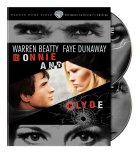| Reviews & Columns |
|
Reviews DVD TV on DVD Blu-ray 4K UHD International DVDs In Theaters Reviews by Studio Video Games Features Collector Series DVDs Easter Egg Database Interviews DVD Talk Radio Feature Articles Columns Anime Talk DVD Savant Horror DVDs The M.O.D. Squad Art House HD Talk Silent DVD
|
DVD Talk Forum |
|
|
| Resources |
|
DVD Price Search Customer Service #'s RCE Info Links |
|
Columns
|
|
|
Bonnie and Clyde: Ultimate Collector's Edition
THE MOVIE:
"At this point, we ain't headin' to nowhere. We're just runnin' from."
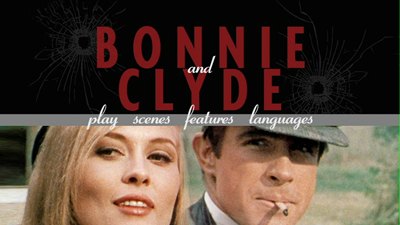
Though originally released on DVD in 1999, Bonnie & Clyde, Arthur Penn's 1967 operatic bloodbath, is finally getting a well-deserved double-dip. This new 2-disc edition features a brand-new, cleaned-up transfer and a second disc of knock-out bonus features. It's available as a standard release for half the price, but fans of the movie are going to want to splurge and get the Bonnie & Clyde: Ultimate Collector's Edition. It contains the same two DVDs, but instead of sticking them in the standard plastic case, the folks at Warner Bros. have put them each in their own hardback book and slid them into a flip-top box. The cover of the box is embossed so that the spider-webs emanating from the mock bullet holes are bumpy to touch. Along with the glossy packaging, the consumer gets two books exclusive to the set, including a stapled reproduction of the original movie press book and a hardback photo book full of images from the movie, behind-the-scenes photos, and even a copy of one of the famous images of the real criminal duo next to its Hollywood recreation. As an added surprise, bound into the center of the photo book is a reproduction of a telegram from Jack Warner to director Penn and the film's star and producer, Warren Beatty, wishing them luck on the start of production.
As far as special packages go, the Bonnie & Clyde: Ultimate Collector's Edition is a classy, well-designed effort, and it's heading to my fancypants shelf to be displayed with my other boxed sets.
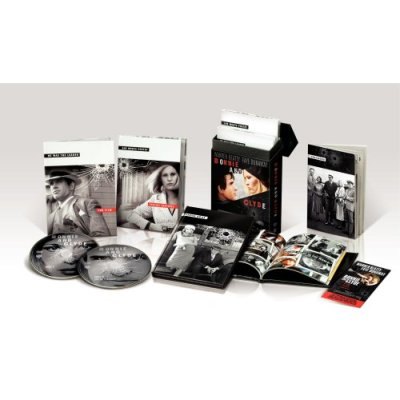
Based on a real-life male/female pair of Depression-era bank robbers, Bonnie & Clyde was revolutionary as the first psychosexual, hyperactive critique of gangster mythology and movie violence. Like many of the films that followed, it both indicted genre cinema for its glorification of crime and killing and exploited the same, reveling in the buckets of blood and the empty shell casings flying from Clyde Barrow's tommy gun. Arthur Penn's use of slow-motion film to show the full effects of bullets ripping through flesh inspired a generation of filmmakers, including the entire wave of Hong Kong directors that emerged in the '80s snd '90s. There would have been no John Woo without Bonnie & Clyde.
The movie opens with Clyde Barrow (Warren Beatty) being spotted by a naked Bonnie Parker (Faye Dunaway) in the midst of trying to steal her mother's car. Their eyes meet, and like so many cinematic couples before them, something passes between them. Love at first sight, a chemical explosion from lust, it's hard to say exactly what. Clyde walks Bonnie into town, escorting her to her waitressing job while extolling her with tales of his criminal past. Whether she believes his boasts or not, she challenges him to prove it. Pistol drawn, Clyde strolls into the general store and empties the cash register. A dangerous couple speeds out of town and into infamy.
The mutual seduction of Bonnie and Clyde is also a seduction of the audience. We want to see their crime spree, we want to believe that these two thrill junkies living on the edge are righteous. The banks they rob are mythologized as being the crushing fists of the Man, and though Bonnie and Clyde were no Robin Hoods, they did enjoy a certain folkloric fame. With the common man's money disappearing and the system failing, the blame had to be put somewhere. It's fitting, however, that whenever Clyde does go on one of his political tirades--scenes where Warren Beatty's clipped manner of speaking especially serves to take his performance into the stratosphere--his ideas are scattered and half-baked. When he claims that he'll stop robbing when the economy improves, not even Bonnie believes him. Yet, Arthur Penn knows his audience wants to, and he relies on that to keep us watching as their path meanders across the American South.
In Death Proof last year, Quentin Tarantino made a whole story point out of the notion of delayed gratification. Some moviegoers were stupefied by the long conversations about bedroom problems that seemed to be standing in the way of the gore. It's another trick borrowed from Penn, as much of Bonnie & Clyde's narrative occupies itself with the downtime. There is a lot of running and hiding that goes into a crime spree. Even when the gang grows, picking up a man-child mechanic (Michael J. Pollard) and Clyde's brother Buck (Gene Hackman) and his shrill wife (Estelle Parsons), it only adds to the boredom. (Robert Altman would take this a step further seven years later in Thieves Like Us, skipping over the action entirely.)
This dissatisfaction and restlessness is felt the most by Bonnie, who longs for alone time with Clyde. She's the one who insists on stopping off to see her mother and who quizzes Clyde about what he would do if they could wipe the slate clean. Her hope is that he will say he would marry her and raise a family, but he can only think of how to become a better crook. Bonnie's frustration is also sexual, as the grand joke being played on our expectation of the virile outlaw is that Clyde Barrow, as depicted here, is impotent. Unable to get off with his woman, he turns to his iron rod, the gun-as-penis metaphor. I suppose if I wanted to, I could give the movie a General Jack Ripper-style reading and note that it's only after Clyde finally does give in to Bonnie's desires that he gets caught, his vaunted sixth sense for detecting "the Laws" failing him once he is divested of his precious bodily fluids.
But that would only serve to deny the inevitability of the fall that this doomed pair would have to suffer. They can only keep running so long before someone is going to catch up with them, and despite the progressive filmmaking on display, Penn is delivering a classic Hollywood "Crime Does Not Pay" message. The takedown of Bonnie and Clyde is not pretty, sexy, or remotely heroic. The little detail it does have is ugly, and if it's spectacular at all, it's only for the level of gore--the overkill, if you will. It's actually not much of a lesson at all, more like a cold, hard fact. Thus, no denouement, just a shift to a title card. "The End."
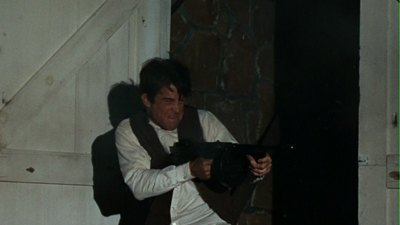
Though much is made of the level of violence in Bonnie & Clyde, which was certainly more blood-soaked than 1967 audiences were used to, the film also looks progressive for how it was shot. It didn't surprise me that both Francois Truffaut and Jean-Luc Godard had been attached (or rumored to be) before Arthur Penn, because Penn's directorial style borrows a lot from the Nouvelle Vague and applies it to a Hollywood genre picture. Given how much the French boys borrowed from classic U.S. genre vehicles, it seems like a fair trade. (The documentary on DVD 2 reveals that the screenwriters had written it hoping to court Truffaut, but after he passed on the project, it was Beatty who told them that though they had written a French script, it needed an American director.)
The story structure is loose, with transitional scenes often missing, giving the movie a feeling of "making it up as they go" in direct imitation of the real Bonnie and Clyde approach. Some of the shots are shaky and even grainy, suggesting they were captured on the fly, getting into the streets the way Godard did in Breathless. Likewise, the acting has an improvisational ring, particularly in the unmannered performances of Beatty and Hackman. They stutter, stumble, and often talk in circles. When Hackman's Buck tells a joke, it sounds like a real joke, not a rehearsed monologue.
For her part, Dunaway has the sexy cool of a Godard heroine, the lithe frame of an Anna Karina but the smoky earthiness of Jeanne Moreau. Like many a femme fatale, she is both sexy and sympathetic, twisted and yet good. Having decided to play in a man's world, she has to act the way the men do. As soon as Buck pulls out his camera, Bonnie takes Clyde's cigar and revolver and strikes an even tougher pose than her boyfriend. Yet, to have these masculine thrills, she has had to sacrifice her womanhood. She can't have a family--hell, she can't even get laid. Putting to rest any notions that she sapped Clyde of something in their lovemaking is the fact that her death is immediately preceded by her indulging in a girly trinket and playing with other little girls in the street. They both gave up their edge when they surrendered to their passions, it wasn't her doing it to him or him doing it to her.
The element that was perhaps the most shocking in 1967, and which also lends Bonnie & Clyde its timeless air, is the gallows humor. Juxtaposed with the exploding squibs are dark jokes and genuine behavioral follies that add an air of levity to the situation. As with any good joke, they also show a greater truth, often exposing the bravado that is used to cover the lingering presence of one's own mortality. The more you laugh, the less real the prospect of dying seems. The minute the joke dies, you find an undertaker in your car or an ambush on the side of the road, and you die, too.
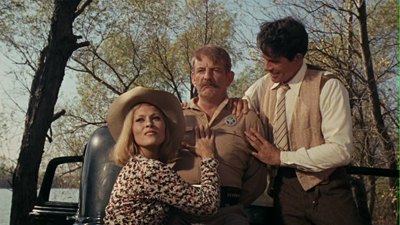
THE DVD
Video:
I never saw the old Bonnie & Clyde DVD, so I can't compare the two, but seriously, that was released in 1999 and this new one is spotless, so it has to be better. Even some of the best discs from back then never looked this good. The colors are rich and strong, and the image is free of any debris. I think I spotted a very faint line down the screen once in the Parker family reunion scenes, but it would have been easily missed if I wasn't keeping an eye out for glitches. There is very little interlacing, and an overall sharp look to everything in this excellent widescreen transfer.
Sound:
The new stereo soundtrack is really good, preserving the up-and-down nature of the original mix. This means that the violent scenes get really, really loud. The music also sounds excellent. I particularly like how the banjo music almost sounds sick when the ailing Barrow car chugs along after a high-speed shootout.
Subtitles are available in English (both regular and for the deaf and hearing impaired), French, and Korean.
Extras:
In addition to the movie, DVD 1 has the teaser trailer and the full theatrical trailer for Bonnie & Clyde.
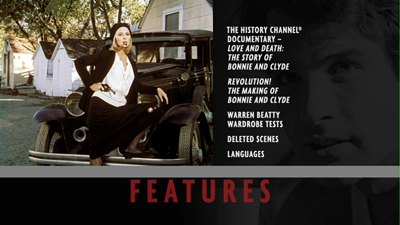
The second disc in this Ultimate Collector's Edition is made-up entirely of supplemental features with over two hours of content. It leads with a rather good, 43-minute History Channel biography of the real-life coupled called Love and Death: The Story of Bonnie & Clyde. The actual story is vastly different and a lot less romantic, and it's interesting to see how the historical figures really looked, minus the myth.
This is followed by three separate but connected documentaries under the banner Revolution! The Making of Bonnie & Clyde. Altogether clocked at 1 hour and 4 minutes, you can watch any of the segments separately or all at once. The individual pieces are titled "Bonnie & Clyde's Gang," "The Reality and Myth of Bonnie & Clyde," and "Releasing Bonnie & Clyde." With most behind-the-scenes featurettes, the older the film, it's usually the better documentary, and this comprehensive overview keeps that rule alive. From inception through production to becoming a phenomenon, this profile has it all. It assembles an amazing list of commentators, including the entire principle cast--Beatty, Dunaway, Pollard, Hackman, Parsons, and Evans Evans (Gene Wilder's girlfriend in the movie). It also has director Arthur Penn, screenwriter Robert Benton, creative consultant Robert Towne, Morgan Fairchild (Faye Dunaway's stand-in), costume designer Theadora Van Runkle, art director Dean Tavoularis, editor Dede Allen, press agent Mick Guttman, and L.A. Confidential director Curtis Hanson. Apparently, as a young photographer, Hanson was instrumental in getting Faye Dunway the part, and in lieu of payment, he asked to be flown to Texas to view the production, his own film school on the fly. It's a story indicative of the kind of tidbits you'll pick up in this piece.
Finishing off the disc are 7 minutes, 35 seconds of Warren Beatty wardrobe tests (the actor trying on different outfits) and two deleted scenes. The scenes are presented without audio, as the source was lost, but they have been subtitled in English and Korean using the shooting script. They take place before and after the first flubbed robbery with C.W., including planning for the heist in a diner and more soul searching following going to the movie theatre.
FINAL THOUGHTS:
Arthur Penn and Warren Beatty's 1967 bloodbath is an American classic retelling a classic American story. Two desperate criminals desperately in love, Clyde Barrow (Beatty) and Bonnie Parker (a stunning Faye Dunaway) cut a villainous swath across the American Southwest, becoming folk heroes to some and a deadly scourge to others. Shot with a looser, more European style, Bonnie & Clyde was a progressive studio picture that tolled the bell for change in Hollywood. Its depiction of violence as a slow-motion ballet had never been seen before. Despite an earlier DVD release, the new Bonnie & Clyde: Ultimate Collector's Edition is the first time this film has really gotten its due in the digital age. Packaged in a handy box with bonus books and a second disc of bonus features, it is part of the DVD Talk Collector Series.
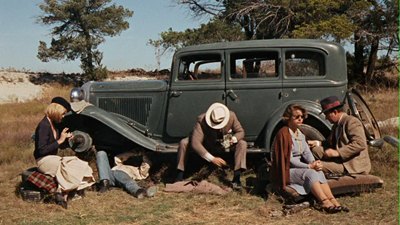
Jamie S. Rich is a novelist and comic book writer. He is best known for his collaborations with Joelle Jones, including the hardboiled crime comic book You Have Killed Me, the challenging romance 12 Reasons Why I Love Her, and the 2007 prose novel Have You Seen the Horizon Lately?, for which Jones did the cover. All three were published by Oni Press. His most recent projects include the futuristic romance A Boy and a Girl with Natalie Nourigat; Archer Coe and the Thousand Natural Shocks, a loopy crime tale drawn by Dan Christensen; and the horror miniseries Madame Frankenstein, a collaboration with Megan Levens. Follow Rich's blog at Confessions123.com.
|
| Popular Reviews |
| Sponsored Links |
|
|
| Sponsored Links |
|
|
| Release List | Reviews | Shop | Newsletter | Forum | DVD Giveaways | Blu-Ray | Advertise |
|
Copyright 2024 DVDTalk.com All Rights Reserved. Legal Info, Privacy Policy, Terms of Use,
Manage Preferences,
Your Privacy Choices | |||||||









